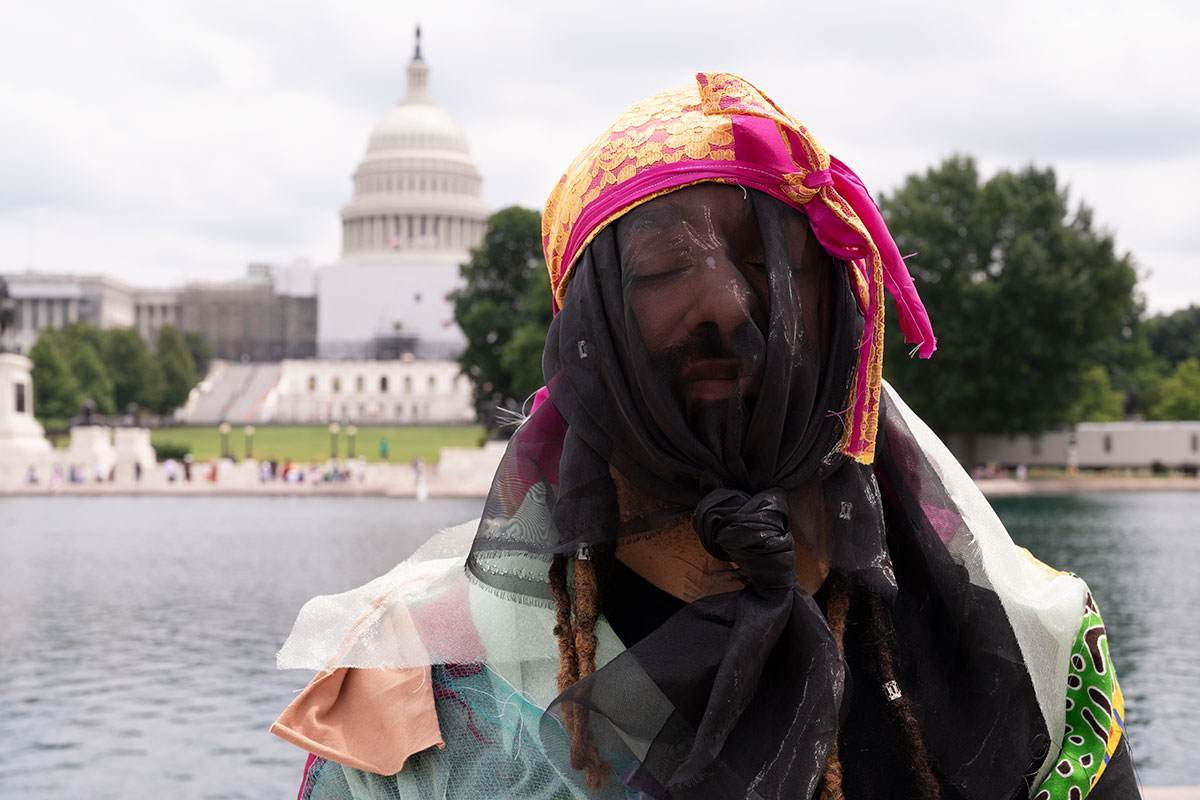Black Queer Sunshine: Cory Perry’s Textile and Performance Art

Cory Perry’s Black Queer Sunshine project culminates at the U.S. Capitol Building.
Photo by Sonya Pencheva, Ralph Rinzler Folklife Archives
On the last day of the 2023 Smithsonian Folklife Festival, the clouds hang low in the sky, threatening a storm. Our production team calls off outdoor activities and arranges for activities to continue within the Arts and Industries Building and the National Museum of the American Indian. Light rain shakes from the sky and a few winds gust at the tents. But the impending storm takes its time. On the empty lawns, volunteers, staff, interns, and participants get to work breaking down tables and tents.
Amid the strike, Cory Perry gets to work, too. They sit at their tent and sew a quilt with their partner, Jacob Archer. Glitter on the textiles glints in the low light.
*****
Perry, a multimedia artist in The Ozarks: Faces and Facets of a Region, is soft-spoken. They sew with a quiet, exacting attention to the story they want to tell with the fabric. Born and raised in Fayetteville, Arkansas, they learned quilting from their grandmother—though not in the traditional sense. They learned the fundamentals of the tradition from their grandmother’s floral arrangements. The colors and textures of the flowers inspired them to explore their artistry.
“I feel like a lot of that brushed off on me—thinking about design and color and beauty and what could be told through these arrangements,” Perry reflects. “That’s sort of how I see quilting.”

Three quilts hung in their tent, “Stories in Fabric,” each part of a series called The Redline Muses. The series, whose name refers to racist housing practices during Jim Crow, responds to current processes of gentrification that transform communities in Northwest Arkansas. The quilts preserve the tangible heritages of communities in flux. Patchworks of clothing, tablecloths, and other textiles depict particular social spaces. For example, a “translucent, shimmery textile” represents a queer space.
“This was my way of archiving and telling that story,” they say. “There is also an aspect of recovering memory and rebuilding the memory.”
At the Festival, Perry mulled over the significance of working on the National Mall as a Black queer artist from the Ozarks. “[I was] thinking about the AIDS quilt, and that type of queerness in the textile. I was also thinking about the March on Washington and about how Blackness exists,” they say.
They thought about current politics, too. National anti-LGBTQ+ legislation and ideologies pervade local Arkansas spaces. “The Walton Arts Center canceled all drag youth story time,” Perry reflects. Yet, Black queer spaces in the Ozarks persist. People find ways to be free.
“Black queerness in the Ozarks exists,” Perry insists. “And it doesn’t exist in a monolith. We exist on different levels. We’re always reinventing ways of existing, reinventing spaces, and ways to move through space.”
Perry’s textiles are a kind of reinvention. In the gloomy weather of the last morning of the Festival, Perry finished the project they had worked on for two weeks: a patchwork durag with a tail long enough to double as a cape. Black, red, and green symbolize the African American flag and the African diaspora at large. The outline of a fist is embroidered in the billowing fabric. “There’s these different layerings of care of the mind, of Blackness, Black thought, Black imagination,” they say.
Embroidered across blacks, reds, and faint blues reads the title of the project: Black Queer Sunshine.


*****
The title works on a few levels. First, the Festival is hot. “I was thinking about the sun as a fiery ball in the sky and experiencing the heatwave that we were going through,” they say. In another way, queerness itself is sunshine. “[I’m thinking about] queerness in a range of emotions, both happy, giving birth in a type of way of going about it, but also the rage in it—especially experiencing the political pushback at the time.”
And Black Queer Sunshine isn’t just a textile project. It’s a performance, too. A Black queer person walks barefoot from the Folklife Festival grounds to the U.S. Capitol Building, as if to thwart a storm. Or, to tell the storm that this body can weather it. It is to become the sun when the climate is unbearable. It is to say, in Perry’s words, “We are here. We are present in the face of this entity that is actively working against us.”
When the moment comes, Perry places the durag on their head. Black translucent fabric veils their face. Pieces from the jacket of a friend, Blanca, and clothing from another friend, Veronica, stretch across their back. Perry thinks of the legacies of Black and queer activists and artists on the National Mall.
“I carry these people with me. I carry our experience, our emotions, our happiness, our rage on the National Mall.”
They say a prayer. They remember those who came before them. They remove their shoes and let their bare feet carry them forward. Archer walks by their side. A deep trance takes hold. The rest of the procession is between them and the ancestors.
“Are you sure your feet are okay?” a staff member whispers as they cross Fourth Street back toward the Festival. “You’ve got tough soles.”
Through the veil, Perry smiles. “In more ways than one.”






Aidan Keys is a research assistant for the Folklife Festival’s Ozarks program and a PhD student in the African and African Diaspora Studies Department at the University of Texas at Austin.

